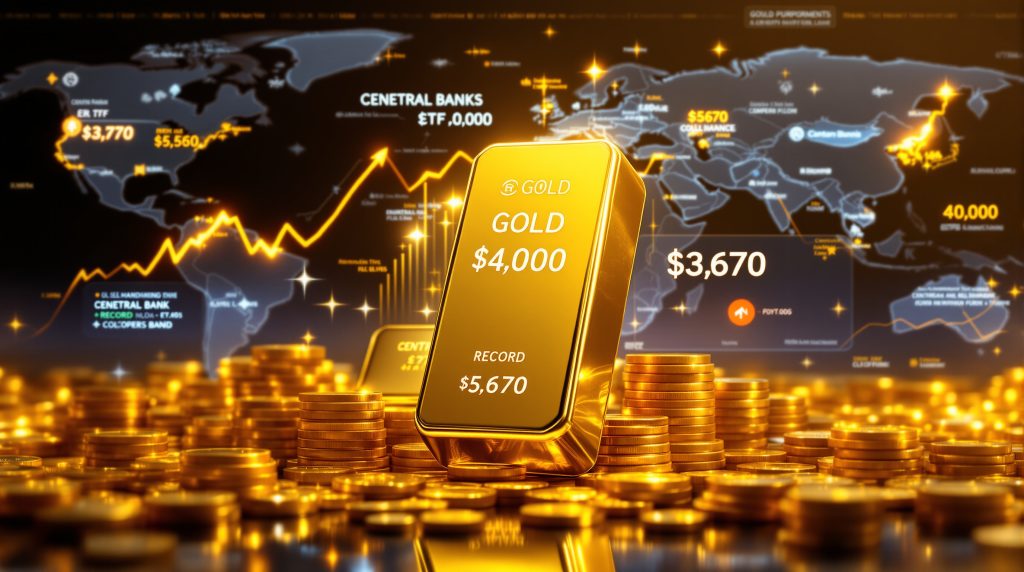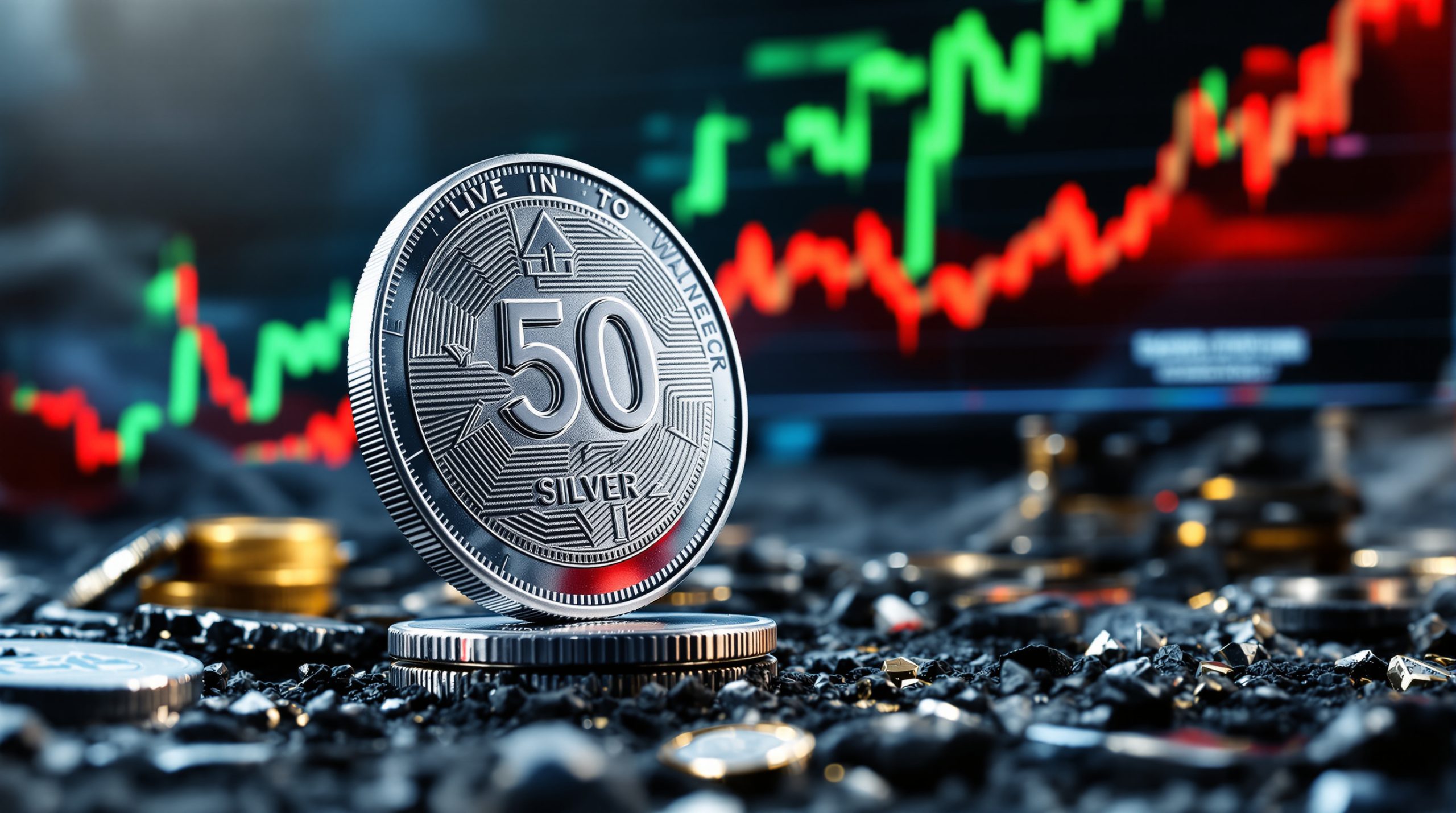Understanding the Gold Price Surge: Factors Driving Record Highs
Gold prices have soared to unprecedented heights, captivating investors and market watchers alike. This precious metal's remarkable ascent has been fueled by a combination of economic uncertainties, changing central bank policies, and growing investor demand. With gold trading past $3,670 per ounce, many are wondering what's driving this gold price surge and how long it might continue.
What's Behind Gold's Recent Record-Breaking Rally?
The current gold rally represents the culmination of several powerful market forces converging simultaneously. Understanding these drivers provides crucial context for both seasoned precious metals investors and newcomers considering an allocation to gold.
Central Bank Purchasing Trends
Central banks worldwide have emerged as consistent, strategic buyers of gold since 2022, creating a solid foundation of demand that continues to support prices. This purchasing behavior represents a significant shift in reserve management philosophy:
- Strategic diversification has become a priority for central banks seeking to reduce dependence on traditional currency reserves, particularly following the Ukraine-Russia conflict
- Reserve managers are increasingly viewing gold as a hedge against currency volatility and geopolitical uncertainty
- Institutional holdings have increased by approximately 14% since May 2024 alone
- Many central banks are actively reducing exposure to Western currencies in favor of hard assets like gold
This steady institutional buying has created persistent upward pressure on gold prices, establishing a price floor that continues to rise with each passing month.
Investor Sentiment and ETF Flows
While central banks have provided baseline support, the more recent surge in gold prices has been largely driven by significant inflows into gold-backed exchange-traded funds (ETFs):
- Gold ETF inflows have accelerated dramatically since May 2024
- Institutional investors are reassessing portfolio risk profiles in response to economic uncertainty
- A clear two-tier investment approach has emerged between physical gold holdings and mining equities
- Until recently, physical gold ETFs have seen consistent inflows while mining equity funds experienced outflows
- This disconnect has begun narrowing as mining stocks catch up to physical gold performance
The ETF investment channel has democratized gold investment, allowing both retail and institutional investors to gain exposure without the complications of physical storage, driving substantial new capital into the gold market.
Macroeconomic Catalysts
Broader economic conditions have created an exceptionally favorable environment for gold:
- Markets are pricing in Federal Reserve interest rate cuts, historically a positive catalyst for gold
- Since abandoning the gold standard in 1971, gold has appreciated at approximately 8% annually
- Growing concerns about fiscal deficits in Western economies have increased gold's appeal as a store of value
- The inverse relationship between real interest rates and gold prices continues to drive investment flows
- Economic uncertainty has highlighted gold's historical role as a portfolio diversifier
With these multiple catalysts aligning simultaneously, gold has found strong support from various market segments, propelling prices to record‐breaking prices.
How High Could Gold Prices Go?
With gold trading at unprecedented levels, investors naturally wonder about its potential ceiling. While predictions vary widely, examining expert forecasts alongside technical and fundamental factors provides valuable perspective.
Expert Price Projections
Professional analysts have been regularly revising their gold price forecast outlook upward as previous milestones are surpassed:
- Current trading around $3,670 per ounce represents a significant premium to previous all‐time highs analysis
- Year-end forecasts generally cluster around the $3,800 mark
- From current levels, reaching $3,800 represents a relatively modest percentage increase
- Long-term projections increasingly suggest potential for $4,000 by mid-2026
- Some analysts point to an eventual target near $4,500 based on monetary supply expansion metrics
It's worth noting that price forecasts typically become more conservative the further they extend into the future, reflecting inherent market uncertainty.
Technical Price Analysis
Chart patterns and technical indicators provide additional insight into gold's potential trajectory:
- Gold has consistently established higher support levels during its current uptrend
- Volume patterns show increasing participation during price advances, a bullish indicator
- Momentum oscillators suggest the rally remains intact despite periodic overbought conditions
- Previous bull market cycles demonstrate gold's capacity for extended uptrends once key resistance levels are broken
- Current volatility metrics remain below previous bull market peaks, suggesting potential for further upside
Technical analysts generally view the current gold chart pattern as constructive for continued upward movement, though periodic consolidations should be expected.
Fundamental Valuation Metrics
Beyond technical factors, several fundamental metrics help gauge gold's relative value:
- The gold-to-silver ratio has normalized somewhat from extreme highs but remains above historical averages
- Gold prices relative to monetary base expansion suggest fair valuation at current levels
- Inflation-adjusted comparisons to previous bull market peaks indicate potential room for further appreciation
- Currency debasement metrics correlate strongly with gold's long-term price trajectory
- Real interest rates (nominal rates minus inflation) remain supportive of higher gold prices
These fundamental measures suggest gold's current valuation, while elevated in nominal terms, remains reasonable within historical context when adjusted for monetary expansion and inflation.
How Do Gold Mining Stocks Compare to Physical Gold?
For investors seeking exposure to the gold sector, understanding the relationship between physical gold and mining equities is essential for portfolio construction and optimization.
Performance Correlation Analysis
Gold mining stocks and physical gold demonstrate a consistent but complex relationship:
- Mining stocks traditionally exhibit a 2:1 leverage ratio to physical gold movements
- After underperforming in 2024, mining equities have entered a "catch-up phase" in 2025
- The disconnect between physical gold inflows and mining equity fund outflows has begun narrowing
- At current gold prices, major producers are generating exceptional profit margins and free cash flow
- Junior miners and exploration companies typically offer higher beta exposure but with increased volatility
This leverage effect means mining equity dynamics potentially offer amplified returns during bull markets, though they typically decline more sharply during corrections.
Mining Company Fundamentals
The operating environment for gold miners has improved dramatically with higher gold prices:
- Production costs have stabilized for many producers despite inflationary pressures
- All-in sustaining costs (AISC) for tier-one producers generally range from $1,200-$1,600 per ounce
- Current gold prices provide profit margins exceeding $2,000 per ounce for many producers
- Balance sheet improvement has accelerated, with many companies becoming debt-free
- Dividend yields have expanded significantly, with some major producers offering yields above 3%
This improved financial position means many gold mining companies are better positioned to weather potential volatility than during previous cycles.
Investment Strategy Considerations
Investors should consider several factors when allocating between physical gold and mining equities:
- A 10% strategic position in physical gold provides portfolio diversification benefits
- Dollar-cost averaging into positions helps mitigate timing risk in this volatile sector
- Rebalancing when allocations drift significantly from targets can enhance long-term returns
- Mining stocks offer higher potential returns but with correspondingly higher volatility
- Royalty companies provide a middle ground with reduced operational risk compared to miners
Many professional investors maintain a balance between physical gold holdings and mining equities to optimize their precious metals exposure.
What's Driving Silver's 14-Year Price Peak?
Silver has reached a 14-year high alongside gold's rally, though its price drivers differ in important ways. Understanding silver's unique characteristics helps explain its performance and potential.
Dual-Purpose Metal Dynamics
Unlike gold, silver serves both industrial and investment purposes:
- Industrial applications account for approximately 50% of silver demand
- Investment demand constitutes the remaining 50%, creating a hybrid demand profile
- This dual nature creates higher volatility compared to gold
- Retail investor participation tends to surge during precious metals bull markets
- The gold-to-silver ratio serves as a key metric for relative valuation
This balanced demand profile means silver responds to both economic growth indicators and monetary concerns that drive gold.
Industrial Demand Factors
Silver's industrial applications continue to expand in critical growth sectors:
- Solar panel production represents a significant and growing source of demand
- Electronics manufacturing requires silver for conductivity and reliability
- Medical applications leverage silver's antimicrobial properties
- Automobile production incorporates silver in various electronic components
- Manufacturing applications span diverse industries from textiles to water purification
As technology continues advancing, particularly in renewable energy and electronics, industrial silver demand maintains a strong growth trajectory.
Investment Appeal Elements
Silver's investment characteristics share similarities with gold but with important distinctions:
- Lower per-ounce price makes silver more accessible to retail investors
- Higher volatility offers potential for greater percentage gains during bull markets
- Historical performance during inflationary periods has been strongly positive
- Silver typically outperforms gold during the later stages of precious metals bull markets
- Physical silver offers similar portfolio diversification benefits to gold
These factors make silver particularly attractive to investors seeking precious metals exposure with potentially higher upside, albeit with increased volatility.
How Does Copper Fit into the Precious Metals Picture?
While not technically a precious metal, copper's performance has increasingly correlated with gold and silver, reflecting its critical role in the global economy and energy transition.
Supply Constraints Analysis
Copper faces significant supply challenges that support its price outlook:
- New mine development typically requires 7-10 years from discovery to production
- Weather-related disruptions have increased with climate change, affecting major copper-producing regions
- Geopolitical tensions in key mining jurisdictions add uncertainty to supply forecasts
- Capital requirements for new copper projects have escalated dramatically
- Ore grades at existing mines continue declining, necessitating more processing for the same output
These supply constraints create a structural support for copper prices that may persist for years.
Demand Growth Catalysts
Several powerful trends are driving copper demand growth:
- AI infrastructure expansion requires substantial copper for data centers and cooling systems
- The energy transition necessitates copper-intensive technologies like electric vehicles and renewable energy
- Electric vehicle production uses 3-4 times more copper than conventional vehicles
- Grid modernization projects globally incorporate significant copper components
- Emerging market development continues driving baseline industrial demand
These combined demand factors have helped push copper prices up approximately 13% year-to-date, with many analysts forecasting continued strength.
Price Correlation with Gold and Silver
Copper's relationship with precious metals offers interesting insights for portfolio construction:
- Traditionally, copper showed stronger correlation to economic cycles than monetary factors
- Recent years have seen increased correlation between copper and precious metals
- Copper typically outperforms during periods of synchronized global growth
- The copper-to-gold ratio serves as a useful economic indicator
- Portfolio diversification benefits exist from including both copper and precious metals exposure
Understanding these relationships helps investors optimize their metals exposure across different economic scenarios.
What Geopolitical Factors Are Supporting Gold Prices?
Gold has historically served as a safe haven during periods of geopolitical uncertainty, a role that continues supporting prices in the current environment.
Global Conflict Zones
Several ongoing conflicts have heightened investor concern and increased gold's appeal:
- The Ukraine-Russia situation has fundamentally altered global security perceptions
- Middle East tensions continue creating energy market uncertainty
- Trade relationship deterioration between major economies has increased economic fragmentation
- Currency competition questions have emerged regarding reserve status and settlement systems
- Nuclear proliferation concerns have expanded to additional regions
These persistent conflict zones create a backdrop of uncertainty that traditionally benefits gold prices.
Economic Uncertainty Elements
Beyond direct conflicts, broader economic concerns support gold's traditional role:
- Western fiscal deficits have reached historically high levels during relatively prosperous times
- Debt sustainability questions have emerged as interest expenses consume larger budget portions
- Political polarization affects economic policy predictability in major economies
- Central bank independence faces increasing scrutiny in several jurisdictions
- Currency debasement concerns have intensified with expanded monetary policies
These structural economic challenges create an environment where gold's role as a store of value becomes increasingly attractive.
Portfolio Protection Strategies
Investors have responded to these uncertainties with specific portfolio positioning:
- Asset allocation shifts have favored traditional safe havens including gold
- Correlation benefits during market stress periods enhance gold's appeal
- Historical performance during geopolitical crises demonstrates gold's protective qualities
- Institutional positioning has become increasingly defensive
- Liquidity preferences have increased amid uncertainty, benefiting easily tradable assets like gold
These protection-focused strategies have contributed significantly to gold's recent price strength.
How Should Investors Approach Gold in Their Portfolios?
For investors considering gold exposure, developing a structured approach helps optimize results and manage volatility.
Strategic Allocation Framework
Professional portfolio managers often recommend a disciplined allocation approach:
- A 10% portfolio position in physical gold provides meaningful diversification benefits
- Implementation through dollar-cost averaging helps mitigate timing risk
- Rebalancing when allocations drift significantly from targets captures volatility
- Position sizing should consider correlation benefits with other asset classes
- Long-term perspective remains essential given gold's periodic volatility
This strategic approach treats gold as a permanent portfolio component rather than a tactical trading vehicle.
Investment Vehicle Comparison
Investors can access gold exposure through various vehicles, each with distinct characteristics:
- Physical bullion offers direct ownership but requires secure storage
- Gold ETFs provide convenient exposure without storage concerns
- Mining equities offer operational leverage to gold prices with additional factors
- Royalty companies provide a hybrid exposure with reduced operational risk
- Options and futures allow leveraged exposure but require sophisticated understanding
Most comprehensive gold investment strategies incorporate multiple vehicles to optimize exposure across market performance surge.
Risk Management Approaches
Effective gold investing requires understanding and managing several risk factors:
- Volatility expectations should reflect gold's historical price behavior
- Correlation benefits with traditional assets typically increase during market stress
- Liquidity considerations vary significantly across different gold investment vehicles
- Tax efficiency comparisons favor certain structures depending on jurisdiction
- Currency exposure effects should be considered for international investors
These risk management considerations help investors maintain their gold exposure through inevitable market fluctuations.
What If Rate Cuts Disappoint Market Expectations?
Gold prices have partially reflected anticipated Federal Reserve rate cuts, raising questions about potential performance if monetary policy disappoints market expectations.
Short-Term Price Impact Analysis
Historical patterns suggest several potential scenarios:
- Initial negative price reaction typically follows policy disappointment
- Magnitude of correction generally correlates with the degree of disappointment
- Technical support levels between $3,400-$3,500 would likely be tested
- Trading volume patterns during policy shifts provide insight into sustainability
- Recovery timeframes have historically ranged from weeks to months depending on underlying fundamentals
While short-term volatility is possible, the broader structural support for gold extends beyond interest rate expectations.
Long-Term Investment Case Resilience
Several factors support gold's long-term case regardless of near-term rate decisions:
- Diversification benefits remain intact across various interest rate environments
- Geopolitical insurance value continues independent of monetary policy
- Portfolio protection during economic uncertainty transcends rate cycles
- Historical performance shows gold's ability to perform across different rate environments
- Physical demand from central banks and retail buyers provides ongoing support
These structural factors suggest the long-term gold investment case remains intact even if short-term catalysts disappoint.
Alternative Scenarios to Consider
Investors should contemplate several potential economic scenarios:
- Stagflation possibilities would likely benefit gold despite interest rate levels
- Currency debasement concerns transcend short-term rate decisions
- Debt sustainability questions remain regardless of monetary policy
- Central bank policy independence challenges could actually increase gold's appeal
- Supply-demand fundamentals continue supporting prices independent of rates
Considering these alternative scenarios helps investors maintain appropriate perspective during potential policy-driven volatility.
FAQ: Gold Investment Fundamentals
What drives gold prices in the current market?
Gold prices currently respond to multiple drivers, including central bank purchasing (which accelerated following the Russia-Ukraine conflict), strong ETF inflows (up approximately 14% since May 2024), anticipated Federal Reserve rate cuts, and mounting concerns about fiscal deficits in Western economies alongside persistent geopolitical uncertainties.
How do gold mining stocks typically perform relative to gold prices?
Gold mining stocks generally demonstrate a 2:1 leverage ratio to physical gold prices, meaning they typically move about 2% for every 1% move in gold. After underperforming in 2024, mining equities have entered a catch-up phase in 2025, though investment flows into mining equity funds lagged behind physical gold investments until recently.
What percentage of a portfolio should be allocated to gold?
Financial experts typically recommend a strategic allocation of approximately 10% to physical gold within a diversified portfolio. This position should ideally be built gradually through dollar-cost averaging rather than all at once, with periodic rebalancing to maintain the target allocation as prices fluctuate.
How does silver differ from gold as an investment?
Silver functions as a hybrid metal with approximately 50% industrial demand and 50% investment demand, creating higher volatility than gold. This dual nature means silver responds to both economic growth indicators (through industrial applications like solar panels) and monetary factors that drive gold. Silver typically outperforms gold during strong precious metals bull markets.
Further Exploration
For investors interested in deeper understanding of precious metals markets, several additional topics warrant exploration:
- The historical relationship between mining stocks and physical metal through multiple market cycles
- Seasonal patterns in gold and silver prices and their practical investment applications
- Tax treatment differences between various gold investment vehicles
- Strategic approaches to rebalancing precious metals allocations during bull markets
- Physical storage considerations for direct bullion ownership
By developing a comprehensive understanding of these factors, investors can make more informed decisions regarding their precious metals exposure.
Want to Invest in the Next Major Mineral Discovery?
Stay ahead of the market with Discovery Alert's proprietary Discovery IQ model, which delivers instant notifications on significant ASX mineral discoveries and transforms complex mineral data into actionable insights. Explore why major mineral discoveries can lead to significant market returns by visiting Discovery Alert's dedicated discoveries page and begin your 30-day free trial today.




